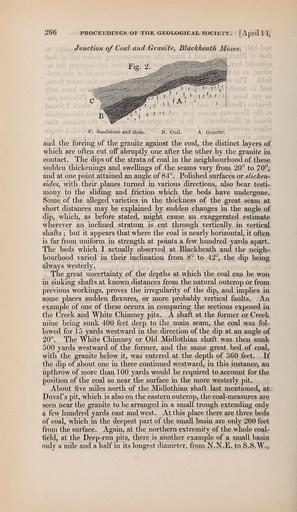MAKE A MEME
View Large Image

| View Original: | The_Quarterly_journal_of_the_Geological_Society_of_London_(13205987463).jpg (1199x2069) | |||
| Download: | Original | Medium | Small | Thumb |
| Courtesy of: | commons.wikimedia.org | More Like This | ||
| Keywords: The Quarterly journal of the Geological Society of London (13205987463).jpg ' 66 PROCEEDINGS OF THE GEOLOGICAL SOCIETY April 14 <br> Jimction of Coal and Granite Blackheath Mines - – ' '-- <br> and the forcing of the granite against the coal the distinct layers of <br> which are often cut off abruptly one after the other by the granite in <br> contact The dips of the strata of coal in the neighbourhood of these <br> sudden thickenings and swellings of the seams vary from 20° to 70° <br> and at one point attained an angle of 84° Polished surfaces or slicken- <br> sicles with their planes turned in various directions also bear testi- <br> mony to the sliding and friction which the beds have undergone <br> Some of the alleged varieties in the thickness of the great seam at <br> short distances may be explained by sudden changes in the angle of <br> dip which as before stated might cause an exaggerated estimate <br> wherever an inclined stratum is cut through vertically in vertical <br> shafts ; but it appears that where the coal is nearly horizontal it often <br> is far from miiform in strength at points a few hundred yards apart <br> The beds which I actually observed at Blackheath and the neigh- <br> bourhood varied in their inclination from 8° to 42° the dip being <br> always Avesterly <br> The great uncertainty of the depths at which the coal can be won <br> in sinking shafts at known distances from the natural outcrop or from <br> previous workings proves the irregularity of the dip and implies in <br> some places sudden flexures or more probably vertical faults An <br> example of one of these occurs in comparing the sections exposed in <br> the Creek and White Chimney pits A shaft at the former or Creek <br> mine being sunk 400 feet deep to the main seam the coal was fol- <br> lowed for 1 5 yards westward in the direction of the dip at an angle of <br> 20° The White Chimney or Old Midlothian shaft was then sunk <br> 500 yards westward of the former and the same great bed of coal <br> with the granite below it was entered at the depth of 360 feet If <br> the dip of about one in three continued westward in this instance an <br> upthrow of more than 100 yards would be required to account for the <br> position of the coal so near the surface m the more westerly pit <br> About five miles north of the Midlothian shaft last mentioned at <br> Duval's pit which is also on the eastern outcrop the coal-measures are <br> seen near the granite to be arranged in a small trough extendmg only <br> a few hundred yards east and west At this place there are three beds <br> of coal which in the deepest part of the small basin are only 200 feet <br> from the surface Again at the northern extremity of the whole coal- <br> field at the Deep-run pits there is another example of a small basin <br> only a mile and a half in its longest diameter from N N E to S S W 36933005 113687 51125 Page 266 Text v 3 http //www biodiversitylibrary org/page/36933005 1847 Geological Society of London Biodiversity Heritage Library The Quarterly journal of the Geological Society of London v 3 1847 Geology Periodicals Smithsonian Libraries bhl page 36933005 dc identifier http //biodiversitylibrary org/page/36933005 smithsonian libraries Information field Flickr posted date ISOdate 2014-03-17 Check categories 2015 August 26 CC-BY-2 0 BioDivLibrary https //flickr com/photos/61021753 N02/13205987463 2015-08-26 12 54 29 cc-by-2 0 PD-old-70-1923 The Quarterly journal of the Geological Society of London 1847 Photos uploaded from Flickr by Fæ using a script | ||||